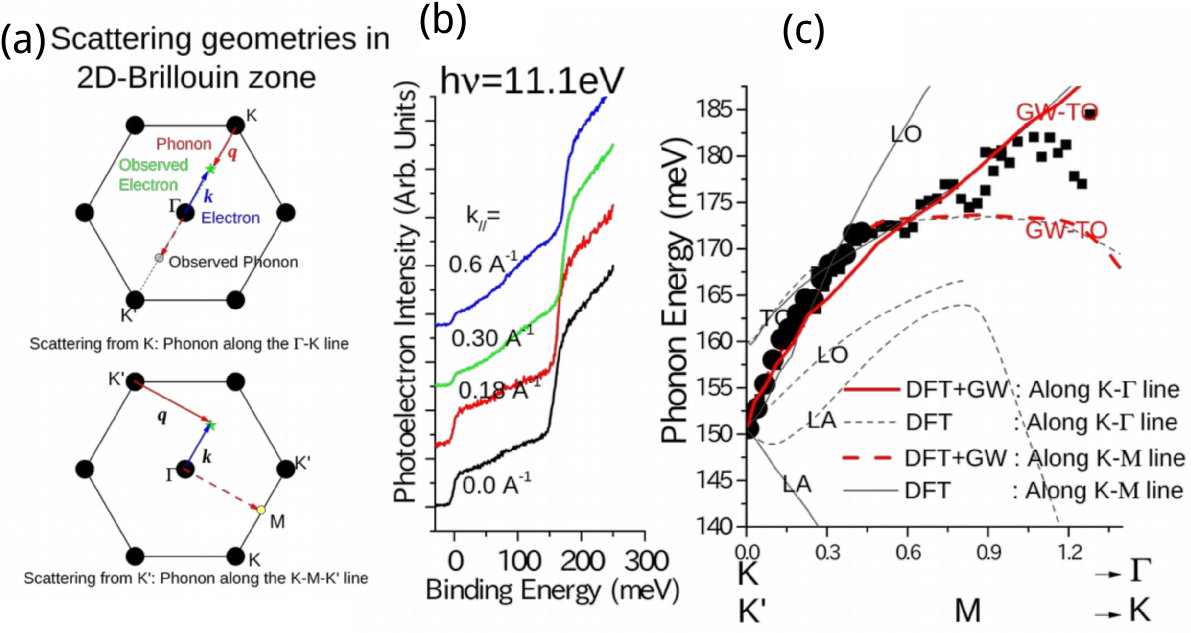




| 09:00-10:40 | Tu1: Transport in electronic devices |
| 10:40-11:20 | Coffee break |
| 11:20-13:00 | Tu2: Surface diffusion and migration |
| 13:00-15:30 | Lunch break (on your own) |
| 15:30-16:40 | Tu3: Chemistry and growth of graphene |
| 16:40-17:20 | Coffee break |
| 17:20-18:50 | Tu4: Electron-phonon coupling in graphene |
| 19:00-21:30 | Poster session A |
Chair: W. Widdra, Halle, Germany
Contributed talk
Momentum-resolved direct-observation of the electron-phonon scattering for graphite and graphene by using ARPES and HREELS
1ISIR, Osaka Univ., Japan
2UVSOR, IMS, Japan
3Osaka Univ., Japan
4HiSOR, Hiroshima Univ., Japan
5ISSP, Univ. of Tokyo, Japan
6Meijo University, Japan
The electron-phonon coupling (EPC) is one of the key issues in the solid/surface state physics. Recently, we proposed a new experimental method which enables us to probe the electron-phonon scattering in HOPG graphite with resolving the momentum and energy of both the electron and the phonon by using the angle-resolved photoelectron spectroscopy (ARPES)[1]. Here, we report recent progresses in the investigation using this method on the single-crystalline graphite and the epitaxial single layer graphene on SiC. When the photon energy is tuned to the excitation to a specific final state, an indirect transition accompanying the electron-phonon scattering can be probed directly by the ARPES[1]. The scattering geometry is shown in Fig.1(a) when the electron emission along the Γ-K line of the graphite is measured, and examples of the ARPES spectra are shown in Fig.1(b). The step-like structures near the binding energy of 150meV are due to the Fermi-edge of the electron, originally located at the K and K' points, scattered into points along the Γ-K line. The energy shift from the Fermi level is ascribed to the energy conservation law in the scattering process and the energy position of the step matches the phonon energy. The momentum conservation law enables us to determine the phonon momentum (except the ambiguity in two lines, K'-Γ and K-M-K'), thus the phonon dispersion can be derived from the experiments as shown in Fig. 1(c) along with the calculation. Only the transverse optical (TO) phonons obtained with the GW-calculation agree the experiments. This indicates that the TO-phonon has much greater efficiency to scatter the electron than the LA or LO phonon in this condition. It should be noted that this phenomenon has a strong photon-energy-dependence. In fact, when a different final state is chosen by changing the photon energy to 7eV, we observe the scattering not by the TO but by the phonons of the interlayer vibration (ZA and ZO modes). In the case of the graphene on SiC, meanwhile, the scattering by the TO phonons is also observed at the photon energy of 10.8eV, but no scattering by ZA or ZO phonons are observed at any photon energies. We will discuss the physical origin of this difference between the graphite and graphene. We also report the high-resolution electron energy loss spectroscopy (HREELS) study for probing the electron-phonon scattering between specific unoccupied bands by tuning the angle and energy of the electron.

Figure 1: (a): Schematic geometry for measuring the phonon dispersion in EPC on single-crystalline graphite, (b): the ARPES spectra near the Fermi level along the Γ-K line, (c): the phonon dispersion obtained by the experiments (dots) compared with calculation (solid and dotted lines).
[1] S. Tanaka et al., Sci. Rep. 3, 3031 (2013)